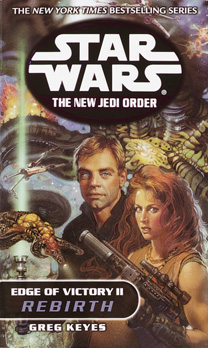After his first book, “Edge of Victory I: Conquest,” spent most of its time on Yavin 4 – one of the “home worlds” of “Star Wars” – Greg Keyes’ sequel, “Edge of Victory II: Rebirth” (2001), flies all over the galaxy, from Tatooine to Eriadu to Yag’Dhul, in a suitably epic follow-up. Additionally, this eighth book in the “New Jedi Order” saga widens its character roster to include all the major players. This novel also marks the birth of a major next-gen character, Ben Skywalker, the son of Luke and Mara.
Ultimately, though, the “Edge of Victory” duology is for Anakin-and-Tahiri ‘shippers, of which I am one. I’ve always liked the idea that they “together are far more powerful than either one was alone” (page 42). Keyes provides hints to the reader that Anakin, 16, and Tahiri, 14, are beginning to see each other as more than best friends, and their kiss in a storage locker amid an escape from the Yuuzhan Vong is among the most giggle-worthy romance scenes in all “Star Wars” novels.
Keyes is solid at referencing past stories – the Yag’Dhul space station previously appeared in the “X-wing” saga and, indeed, Anakin and Tahiri’s friendship was introduced in the “Junior Jedi Knights” books. But “Rebirth” is remarkable for how it foreshadows future stories. On page 134, Anakin describes his vision of a future Tahiri: “You said something about them being the last. Just before you killed them.” I can’t recall if this specific reference pays off, but I do remember that Tahiri assassinates Imperial Grand Admiral Pellaeon in the “Legacy of the Force” series, so certainly, she has some dark moments ahead of her.
A more explicit sneak preview comes on page 273, where Luke has a vision of his son “at the helm of a starship of strange design.” This is a fairly overt reference to Ben flying the Lost Tribe of the Sith’s Force ship in the “Fate of the Jedi” saga, which wouldn’t be written for another eight years. It’s clear that the Lucas Books planning team had specific story ideas in mind for Ben, rather than merely introducing Luke’s offspring now and making up his story as they went along. (It makes one wonder what they had in mind for Allana Solo, whose story got truncated by the EU’s cancellation.)
Speaking of great characters, I had forgotten how compelling Kyp Durron is at this point in the “NJO.” As the grinding gears of bureaucracy prevent the bulk of the New Republic military from fighting the Yuuzhan Vong, and as Luke himself is indecisive about the Jedi’s role in the conflict, Kyp is crucial in taking the fight to the invaders. While I have always somewhat resented Kyp for killing a planet’s worth of people (back in the “Jedi Academy Trilogy” duology) without being punished, Keyes adds depth to this rogue Jedi by revealing that he doesn’t much like himself either. But, able to see himself as a cog in a machine, he believes his role is necessary.
“I’ve become what I need to be. What your uncle Luke was in the war against the Empire,” Kyp tells Jaina on page 139. “… I’m not saying I like what I’ve become. … That doesn’t mean (my war strategies) shouldn’t be done.”
In somewhat of a thesis statement for the “NJO,” Kyp goes on to note that the war against the Yuuzhan Vong is his (and Jaina’s) generation’s war, whereas the fight against the Empire belonged to the previous generation.
While there’s good Luke-Mara and Han-Leia stuff here – and also, Lando and Wedge make overdue returns to the “NJO” saga – a major joy of the post-“Return of the Jedi” books in the 2000s was following this next generation. Although we didn’t know it at the time, these books marked somewhat of split in the “Star Wars” fanbase: Those who loved the next generation as much as the original-trilogy and prequel-trilogy generations, and those who didn’t quite embrace it, and perhaps even stopped reading the books. For the former group, of which I am a member, “The Force Awakens” seems like an alternate dimension of “Star Wars.”
The latter group will get their next generation in December. But I’m content with Jaina, Jacen, Anakin, Tahiri and even Kyp.


